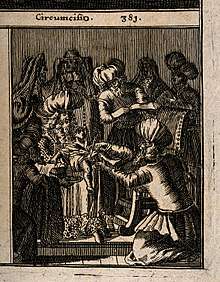Sandek
A sandek (Hebrew: סנדק "companion of child") is a person honored at a Jewish brit milah (circumcision) ceremony, traditionally either by holding the baby boy on the knees or thighs while the mohel performs the brit milah, or by handing the baby to the mohel.[1]

Etymology
The origin of the term has been attributed to a derivation from the Greek sunteknos (syn-, meaning "plus", and tekno, meaning "child"), which means "companion of child".[2]
Customs
Rabbi Moses Isserles (the Rema) recorded the practice of the sandek holding the baby on his thighs (Yoreh De'ah 265:11). The Biur Hagra (YD 265:44) cites the Midrash Shochar Tov, that explains that this is based on Psalm 35:10, which states, "All my bones shall say: 'YHWH, who is like you?'"[3] Midrash outlines how every body part is used in the service of God, and says that the sandek's thighs participate in the service of God by placing the baby on them during the brit.
The Rema records a custom that a father should not honour the same individual twice with being the sandek for his children. The reason is that the sandek is compared to a kohen (priest) offering the ketoret (incense offering) in the Beit HaMikdash (Jewish Temple). The procedure regarding the ketoret is that a kohen does not perform this mitzva (commandment) more than once in his lifetime. God rewards with wealth the kohen who offers the ketoret. Thus, the opportunity is afforded to as many kohanim as possible to become wealthy (Babylonian Talmud Tractate Yoma 26a). Similarly, the opportunity is afforded to as many people as possible to serve as a sandek and receive God's blessing to become wealthy.
The Vilna Gaon (Gra) (YD 265:45) expresses some skepticism regarding this custom. First, based on its reasoning, the custom should have been that one should not serve more than once as a sandek for any child, not just two different children of one family. Second, the Gra writes that no one has become wealthy because he served as a sandek. Nevertheless, the Aruch Hashulchan (Y.D. 265:34) concludes, that the custom recorded by the Rema should be observed. The Aruch Hashulchan notes, though, that the custom in many locales is that the rav (rabbi) of the city serves as the sandek for all the baby boys. The Aruch Hashulchan justifies this practice by comparing the local rav to the kohen gadol (high priest), who had the right to offer a korban (sacrifice) or ketoret any time he desired (see Yoma 14a). Indeed, it is related that the Chazon Ish served as the sandek for innumerable baby boys. Rabbi Yissocher Frand relates that Rav Yaakov Yitzchak Ruderman (the rosh yeshiva (dean) of Yeshivat Ner Yisrael) also served as the sandek for countless baby boys.
The honor was given traditionally to one Jewish male: some older family member (grandfather, great-grandfather), a rabbi, or another important male who was observant and righteous.[2] The sandek also wore the tallit (prayer shawl) and held the baby on a pillow while the mohel completed the circumcision.[2] In modern times, among some more liberal Jews, the sandek may be female, or even non-Jewish.[2] At most ceremonies, there is only a single sandek, but two are permissible, although more than two is uncommon.[2]
During the brit, a chair is sometimes placed next to the sandek's seat. The chair is reserved for the prophet Elijah, and remains unoccupied during the ceremony; this practice is derived from the tradition that Elijah protects children from danger.[4] According to some sources, the sandek is the "representative" of Elijah.[5]
References
- Kogen, Fred R. "Defining Sandek." The Bris Mila
- Kogen. See Jewish Encyclopedia for more detailed etymological coverage
- Psalms 35:10. Translation based on the Jewish Publication Society's 1917 Hebrew Bible translation, Holy Scriptures According to the Masoretic Text
- Kolatch, Alfred J. The Jewish Book of Why. Jonathan David: New York, 1995. ISBN 0-8246-0256-0 .
- Shoulson, Joel. "Orientation." "Archived copy". Archived from the original on 2006-11-08. Retrieved 2006-11-20.CS1 maint: archived copy as title (link).